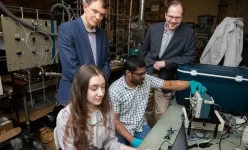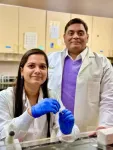(Press-News.org) A stroke often impacts a person’s ability to move their lower body from the hips down to the feet.
This leads to diminished quality of life and mental health in addition to increased susceptibility to falls. But now, UBC Okanagan researchers are exploring new treatment methods to help bridge the service delivery gap, and recovery outcomes, for patients after a stroke.
“Shortened length of inpatient stays and continued challenges in transitioning back to the community—including poor access to continued stroke rehabilitation services—have resulted in substantial unmet recovery needs,” says Sarah Park, master’s student with the Centre for Chronic Disease Prevention and Management (CCDPM) based at UBC Okanagan. “This is especially true for lower extremity recovery. People can struggle to regain balance, stability and gait coordination for daily life activities and even proper ambulation.”
Dr. Brodie Sakakibara, CCDPM Investigator, recently led a national team of researchers, clinicians and people with lived experiences to evaluate the feasibility of a telerehabilitation program with aims to improve lower extremity recovery poststroke.
“More people are surviving a stroke and the need for accessible rehabilitation regardless of geographic location is increasingly important,” says Dr. Sakakibara. “This program harnesses technology, the expertise of clinical therapists and the motivation of individuals to improve stroke recovery.”
For the study, more than 32 participants, all who had experienced a stroke within the past 18 months, received eight telerehabilitation sessions via videoconference with a trained physical therapist. The research team focused their efforts on improving lower body mobility through standardized exercises combined with self-management supports.
“Overall, participants saw improvements in their mobility and strength, and made noticeable progress towards their rehabilitation goals,” says co-investigator Dr. Ada Tang, an Associate Professor with the School of Rehabilitation Sciences at McMaster University. “They also gained self-management skills to empower themselves and maintain their achievements moving forward.”
While many virtual rehabilitation programs developed out of necessity during the COVID-19 pandemic, programs like this have demonstrated feasibility and increased accessibility to patients. Especially those living in rural and remote areas.
However, researchers have noted therapeutic benefits are not maintained if additional therapy is not sustained after the end of a formal program, explains Park, who was also lead author of the study. It is important to incorporate self-management skills in post-stroke rehabilitation interventions, which empower participants to continue exercising and maintain those benefits after the program ends.
“Overall, self-management programs aim to improve health outcomes by helping people adapt to their circumstances through newfound skills, which could prevent or offset some of the difficulties individuals face when discharged from care,” Park explains. “Virtual rehabilitation programs, with a level of self-management, can ultimately enhance the continuum of care for patients transitioning back into the community and help improve their overall quality of life.”
The study was published recently by the Physical Therapy and Rehabilitation Journal.
END
Virtual rehabilitation provides benefits for stroke recovery
New program enhances continuum of care, increases accessibility, quality of life
2024-03-28
ELSE PRESS RELEASES FROM THIS DATE:
Generative AI develops potential new drugs for antibiotic-resistant bacteria
2024-03-28
With nearly 5 million deaths linked to antibiotic resistance globally every year, new ways to combat resistant bacterial strains are urgently needed.
Researchers at Stanford Medicine and McMaster University are tackling this problem with generative artificial intelligence. A new model, dubbed SyntheMol (for synthesizing molecules), created structures and chemical recipes for six novel drugs aimed at killing resistant strains of Acinetobacter baumannii, one of the leading pathogens responsible for antibacterial resistance-related deaths.
The researchers described their model and experimental validation of these new compounds in a study published March 22 in the journal ...
Biofuels could help island nations survive a global catastrophe, study suggests
2024-03-28
A major global catastrophe could disrupt trade in liquid fuels used to sustain industrial agriculture, impacting the food supply of island nations like New Zealand that depend on oil imports.
A new study in the journal Risk Analysis suggests that New Zealand and other island nations dependent on imported fuel can plan for future emergencies by stepping up their production of biofuel from locally grown crops (like canola) and farming more fuel-efficient crops (like wheat and potatoes rather than dairy).
In the event of a major disruption in liquid fuel imports, results showed that New ...
NJIT research team discovering how fluids behave in nanopores with NSF grant
2024-03-28
A research team from New Jersey Institute of Technology is uncovering mysteries surrounding fluids in nanoporous materials, and has been recently awarded a grant from the National Science Foundation (NSF) to support this research.
The research is focused on the elasticity, or compressibility, of fluids in these nanopores. Understanding the elastic properties of fluids has significant implications across multiple disciplines. Engineering applications, geological exploration, materials science and environmental studies ...
New study shows association of historical housing discrimination and shortfalls in colon cancer treatment
2024-03-28
BIRMINGHAM, Ala. – A nationwide study of 196 cities shows that housing discrimination from 90 years ago still casts a historical shadow of inequities in colon cancer care today, S.M. Qasim Hussaini, M.D., of the University of Alabama at Birmingham and colleagues at the American Cancer Society and Johns Hopkins School of Public Health report in the journal JCO Oncology Practice.
In the 1930s, the federally sponsored Home Owners’ Loan Corporation, or HOLC, used racial composition to map out residential areas worthy of receiving mortgage loans and those areas to avoid. Neighborhoods ...
Social media use may help to empower plastic surgery patients
2024-03-28
Waltham — March 28, 2024 — For patients considering or undergoing plastic and reconstructive surgery (PRS) procedures, using social media to gather information and answer questions can enhance patient empowerment – potentially leading to increased autonomy and better decision-making, reports a study in the April issue of Plastic and Reconstructive Surgery®, the official medical journal of the American Society of Plastic Surgeons (ASPS). The journal is published in the Lippincott portfolio by Wolters Kluwer.
"Our study suggests that connecting to social media is associated with meaningful increases in empowerment for PRS patients, ...
Q&A: How to train AI when you don't have enough data
2024-03-28
Artificial intelligence excels at sorting through information and detecting patterns or trends. But these machine learning algorithms need to be trained with large amounts of data first.
As researchers explore potential applications for AI, they have found scenarios where AI could be really useful — such as analyzing X-ray image data to look for evidence of rare conditions or detecting a rare fish species caught on a commercial fishing boat — but there's not enough data to accurately train the algorithms.
Jenq-Neng Hwang, University of Washington professor of electrical and computer and engineering, specializes in these issues. ...
Wayne State University researchers uncover potential treatment targets for Zika virus-related eye abnormalities
2024-03-28
DETROIT - A groundbreaking study published in the journal iScience presents crucial insights into the ocular effects of Zika virus infection during pregnancy and offers promising avenues for therapeutic intervention.
Produced by a team of researchers in the Department of Ophthalmology, Visual and Anatomical Sciences at the Wayne State University School of Medicine, the paper, “Targeting ABCG1 and SREBP-2 mediated cholesterol homeostasis ameliorates Zika virus-induced ocular pathology,” provides compelling evidence of the ...
Discovering Van Gogh in the wild: scientists unveil a new gecko species
2024-03-28
You’ve probably seen nature depicted in art, but how often do you see an artwork hiding in nature?
When they saw the back of a lizard in the Southern Western Ghats, a group of scientists from the Thackeray Wildlife Foundation in India were reminded of Van Gogh’s The Starry Night. As soon as they figured out it was a new species, it was only apt to name it in honour of the famous painter.
“Cnemaspis vangoghi is named for Dutch painter Vincent Van Gogh (1853–1890) as the striking colouration of the new species is reminiscent of one of his most iconic paintings, The ...
Small birds spice up the already diverse diet of spotted hyenas in Namibia
2024-03-28
Hyenas are generalist predators (and scavengers) with a broad range of prey species. They are known for hunting (or scavenging) larger mammals such as antelopes and occasionally feed on smaller mammals and reptiles. Being flexible in the choice of prey is a strategy of generalists – and this even extends to small passerine birds, as scientists from the Leibniz Institute for Zoo and Wildlife Research (Leibniz-IZW) and the University of Ljubljana observed in Namibia: Spotted hyenas pursued red-billed queleas, picked them from the ground or the surface of a waterhole and swallowed them whole, at a success rate of approximately one bird every three minutes. These observations were described ...
Imaging detects transient “hypoxic pockets” in the mouse brain
2024-03-28
Using a bioluminescent oxygen indicator, Felix Beinlich and colleagues discovered a spontaneous, spatially defined occurrence of “hypoxic pockets” in the mouse brain. Their technique offers a way to learn more about brain oxygen tension (pO2), a measure of oxygen delivery and demand in brain tissue that changes dynamically but is not well understood. The findings could have implications for how rest and exercise affect pO2 in the human brain, including the role of these activities in conditions such as dementia, Beinlich et al. suggest. The researchers used a genetically encoded bioluminescent oxygen indicator called Green NanoLuc in mouse cortical astrocytes to ...
LAST 30 PRESS RELEASES:
Clearing the brain of aging cells could aid epilepsy and reduce seizures
Brain injuries linked with potential risk of suicide, new study finds
New technique lights up where drugs go in the body, cell by cell
New study finds movement of fishing fleets can reveal shifts in marine ecosystems
Embargoed: New evidence points to potential treatment for vascular dementia
Study uncovers disrupted brain balance in alcohol dependence
Working in groups can help Republicans and Democrats agree on controversial content moderation online
Structural findings reveal how distinct GPCR ligands create different levels of activation
Anything-goes “anyons” may be at the root of surprising quantum experiments
UC review: Maximizing workplace opportunity for veterans
From generation to complex control: Metasurfaces make perfect vortex beams "within reach"
Thin-film lithium niobate-based detector: recent advances and perspectives
Exploring why some people may tend to persistently make bad choices
How cells balance their protein levels
Nirsevimab vs RSVpreF vaccine for RSV–related hospitalization in newborns
Effectiveness and impact of maternal RSV immunization and nirsevimab on medically attended RSV in US children
AI gives scientists a boost, but at the cost of too many mediocre papers
Next-generation vision model maps tree growth at sub-meter precision
Genes aren’t destiny for inherited blindness, study shows
MIT study: High-fat diets make liver cells more likely to become cancerous
Exposure to multiple fine particulate matter components and incident depression in the US Medicare population
Risk of burdensome health care spending over time in the US
Nirsevimab against hospitalizations and emergency department visits for lower respiratory tract infection in infants
New microfluidics technology enables highly uniform DNA condensate formation
A new strategy for immune tolerance
Super Mario Bros. help fight burnout: New study links classic games to boosted happiness
Deepest gas hydrate cold seep ever discovered in the arctic: International research team unveils Freya Hydrate Mounds at 3,640 m depth.
Integrating light and structure: Smarter mapping for fragile wetland ecosystems
ACA-SIM: A robust way to decode satellite signals over complex waters
Probiotics can restore gut microbiome in breastfed infants
[Press-News.org] Virtual rehabilitation provides benefits for stroke recoveryNew program enhances continuum of care, increases accessibility, quality of life




